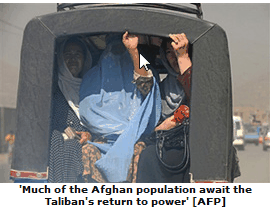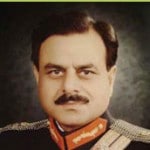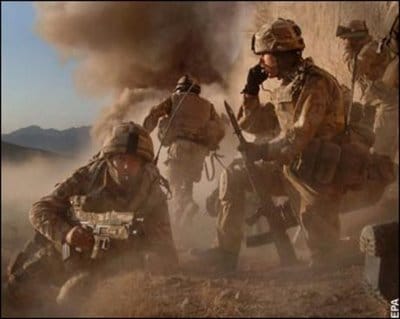By Lieutenant General Hamid Gul
History is about to take a monumental turn in the rugged, desolate hills and dales of Afghanistan where the world’s sole superpower leads an alliance facing defeat at the hands of the nameless resistance fighters of al-Qaeda and the Taliban.
The impact of this enormous defeat will be felt across the globe.
The bloody conflict in Afghanistan has been going on for almost nine years, since October 2001. The Taliban, who appeared to have been defeated at the beginning of the war, has since grown from strength to strength, particularly after 2003 when the International Security Assistance Force (ISAF) of the North Atlantic Treaty Organization (NATO) and the US army started recruiting more troops to bring the Afghan countryside under their sway.
The Taliban, who appeared to have been defeated at the beginning of the war, has since grown from strength to strength, particularly after 2003 when the International Security Assistance Force (ISAF) of the North Atlantic Treaty Organization (NATO) and the US army started recruiting more troops to bring the Afghan countryside under their sway.
From Operation Anaconda in March 2002 (when the US military, CIA paramilitary officers, and other NATO and non-NATO forces attempted to destroy al-Qaeda and the Taliban in Shahi-Kot) to Operation Khanjar in July 2009 – after US President Barack Obama’s first “surge” of 21,000 additional troops (when 4,000 US marines and 650 Afghan troops moved into the Helmand Valley), Taliban fighters have scored numerous victories in minor skirmishes and medium intensity encounters with the occupation forces.
Unbeaten and unbeatable
Today the Taliban stand unbeaten and seemingly unbeatable. Their ranks have swelled and their morale is high.
Obama’s speech of December 1, 2009, was a strong indicator of fatigue and exhaustion on the part of the US and, consequently, signalled an influx of young, enthusiastic Afghan recruits into Taliban ranks.
The political environment of the country, on the other hand, deteriorated further as a result of the heavily-manipulated victory of Hamid Karzai in recent presidential elections.
Karzai’s choice of cabinet is equally disastrous. He refilled ministries with the same corrupt and inefficient warlords who are simply unable to defend against a Taliban onslaught when it comes – possibly in the autumn of 2010.
An additional 30,000 American troops ordered to Afghanistan by Obama, in order to shore up the tottering puppet regime, are unlikely to be of any advantage. In all probability, the occupation forces will be confined to their garrisons and will seldom venture out to face the Taliban in the countryside.
 This strategy will enhance the use of air power, whose collateral damage is likely to further annoy the Afghan people. The Afghan army still has fewer than 90,000 members and has reportedly been penetrated by pro-Taliban elements.
This strategy will enhance the use of air power, whose collateral damage is likely to further annoy the Afghan people. The Afghan army still has fewer than 90,000 members and has reportedly been penetrated by pro-Taliban elements.
Requirements for a political solution
The Afghan narcotics trade proceeds unabated under the very noses of NATO and US forces. Last year’s raw opium production stood at 6,200 tonnes – which accounts for 92 per cent of the world’s consumption of the drug.
A substantial amount of the billions of dollars earned through this trade is funnelled to Taliban cadres whose support is required by the governors and warlords for them to maintain their positions.
The Taliban’s claims that it controls over 80 per cent of Afghan territory may be exaggerated, but Robert Gates, the US defence secretary, has publicly conceded that 11 provinces out of 32 are under the control of opposition forces.
Given this scenario, one can conclude that a military solution to the Afghan imbroglio is out of the question. It now remains for the world community to find a political solution that will be able to meet the following requirements:
- A graceful withdrawal of the occupation forces from Afghanistan;
- A workable system of governance after the withdrawal; and
- Continued interest and engagement in Afghanistan’s rehabilitation and reconstruction.
Thus far, these objectives have not been crystallised. The countries which will be most severely affected as a result of the US defeat – i.e. other countries in the region and the countries of the Muslim world – are completely marginalised and seem not to be involved in any kind of peace process which must begin before matters run out of control. Before we delve into the exercise of examining paths to peace, there are certain critical factors which must be considered: the role of external players; the ethnic make-up of Afghanistan and the role of al-Qaeda.
Before we delve into the exercise of examining paths to peace, there are certain critical factors which must be considered: the role of external players; the ethnic make-up of Afghanistan and the role of al-Qaeda.
External players
On taking over the American administration, Obama outlined his Afghan policy and created a contact group of four countries: Russia, China, Iran and India.
He conveniently omitted Pakistan and Saudi Arabia, without whose participation peace in Afghanistan will remain illusory. China and Russia are important but peripheral to any serious attempt at Afghan reconciliation.
Iran’s influence is limited to the Shia communities who do not exercise any sizeable politico-cultural influence. India, in spite of its $1.2bn investment in Afghanistan, remains very much alien to mainstream Afghan society. Its clout can work only with a few hundred influential individuals in the present regime but not with any of the social or political cadres.
The Taliban, in particular, would be averse to any kind of Indian involvement in the future of Afghanistan. The Afghan nation will not forget that India was an ally of the USSR when the latter invaded and wreaked havoc in Afghanistan. India is now piggybacking on the US – against the will of the Afghan people.
Ethnic composition
Afghan society is comprised of 58 per cent Pashtuns (who are the main supporters of the Taliban), 22 per cent Tajiks, eight per cent Uzbeks, seven per cent Hazaras (mostly Shia) and five per cent of other ethnicities, including Kyrgyz, Baluch, Aimak and Arabs.
The Pashtuns, due to their numerical superiority, will hold a virtual veto in any future Afghan political setting. Presently, members of this ethnic group feel marginalised and discriminated against.
Even though the Afghan national sentiment is remarkably cohesive, ethnic divisions continue to vitiate the socio-political scene. Afghan history is testimony to the fact that a strong-willed ruler with a loose system of governance is the only recipe for lasting peace.
The future, therefore, points to a dominant role for the Taliban who have, in the past, shown strength of character, sterling political will and adherence to legal justice in accordance with the Shariah.
Despite their several mistakes with regard to the treatment of women and the use of force in shaping cultural behaviour, the Taliban remain very relevant to Afghan society. According to one estimate, 70 per cent of the Afghan nation is waiting for the Taliban to return to power – albeit with a reformed code of conduct.
Al-Qaeda is no longer a monolithic organisation; it has converted itself into a global franchise. Its cadres have been relocated, and there is currently only a small al-Qaeda presence in Afghanistan.
The Western claim that its leadership is hiding in parts of Pakistan is ridiculous and meant only to pressurise Pakistan into “doing more”.
Most al-Qaeda field operatives have moved out and found new battlegrounds in the Middle East and Africa as they have succeeded in bleeding and debilitating the American might in the Afghan theatre of war.
Possible way out
‘Much of the Afghan population await the Taliban’s return to power [AFP]
Obama has, at least, opened the door for negotiations by announcing a timeline for the commencement of troop withdrawal from Afghanistan. Nevertheless, other parties who are affected by the Afghan conflict need to rally to find a solution before time runs out.
The Organization of Islamic Conference (OIC) could be an effective forum if it were to close ranks and not be content only with taking the cue from America.
An independent OIC stance will open a vista of possibilities if its efforts were to be combined with a powerful delegation of ulama (religious scholars) from Muslim countries. Pakistan, Saudi Arabia and Iran will have to take the lead role in this regard.
A visible paradigm shift in US policy would be a basic prerequisite for the initiation of any meaningful dialogue to resolve this conflict. Once a change of heart becomes evident and the US demonstrates irreversible movement towards allowing Afghans to control their own destiny, other matters will fall into place rather quickly. But if ambivalence continues to show in the US’ stance, the Afghan imbroglio could stretch out for years to come. Some of the imperatives that must be addressed to proceed with the beginning of meaningful dialogue in Afghanistan are:
- A US declaration of the final date of evacuation from Afghanistan;
- The removal of the “terrorist” label from the Afghan resistance movement; and
- The unconditional release of all Afghan prisoners inside and outside the country.
While searching for a solution, the following points must be kept in mind:
- Afghanistan is an ideological conflict, and any attempt to find a diversionary approach will not succeed;
- A coalition government brokered by outside forces will have a short lifespan;
- An imposed solution will be counter-productive – just as the Bonn dispensation turned out to be a disaster. The solution must be a purely Afghan solution arrived at on Afghan soil;
- Any effort to find accommodation for marginal interests or to create an American proxy will fail to achieve results; and
- Finally, it must be remembered that Afghans are fiercely independent people, and they will never compromise on their freedom, faith and honour. But if a settlement takes place on fair and equitable terms, they can easily be assimilated into the global community. They are capable of progressing and developing rather quickly if left to their own devices.

Lieutenant General Hamid Gul HI(M) SI(M) SBt (Urdu: حمید گل; 20 November 1936 – 15 August 2015) was a three-star rank army general in the Pakistan Army and defence analyst. Gul was notable for serving as the Director-General of the Inter-Services Intelligence (ISI), Pakistan’s premier intelligence agency, between 1987 and 1989. During his tenure, Gul played an instrumental role in directing ISI support to Afghan resistance groups against Soviet forces in return for funds and weapons from the US, during the Soviet-Afghan War, in cooperation with the CIA.
In addition, Gul was widely credited for expanding covert support to Kashmiri nationalist groups against neighbouring rival India in the disputed Kashmir region from 1989, diverting focus from the fallout of the Soviet war. Gul earned a reputation as a “Godfather” of Pakistani geostrategic policies. For his role against India, he has been considered by A. S. Dulat, former director of RAW, as “the most infamous ISI chief in Indian eyes.”Following an escalation of the Kashmir militancy in India and the Taliban insurgency in Afghanistan, he was even accused by the United States and India of having ties to Islamic terrorist groups, notably Al-Qaeda and the Lashkar-e-Taiba.
In 1988 Gul also played a role in the creation of the IJI, a conservative political alliance formed to oppose the PPP of Prime Minister Benazir Bhutto.
On 15 August 2015, he died after suffering a brain haemorrhage.
ATTENTION READERS
We See The World From All Sides and Want YOU To Be Fully InformedIn fact, intentional disinformation is a disgraceful scourge in media today. So to assuage any possible errant incorrect information posted herein, we strongly encourage you to seek corroboration from other non-VT sources before forming an educated opinion.
About VT - Policies & Disclosures - Comment Policy




